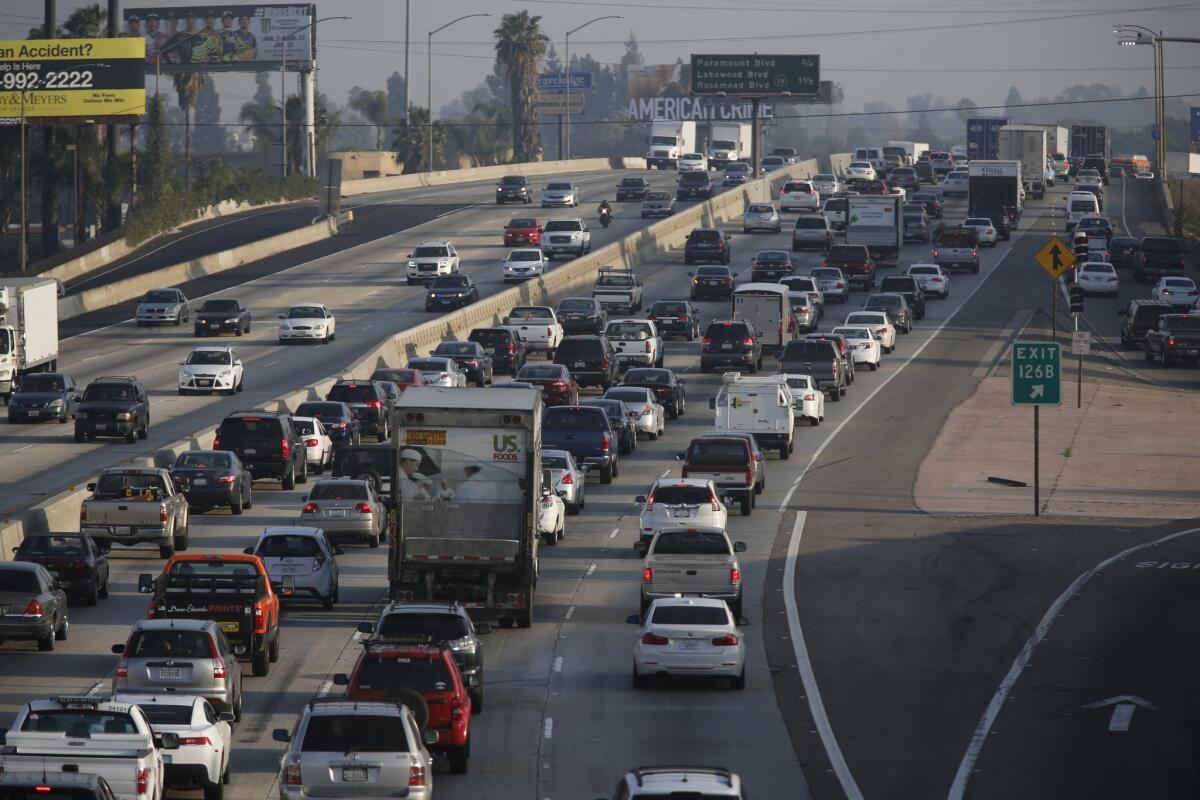California Commute: State’s 5 worst bottlenecks are in L.A., Orange counties

During the evening rush hour, a section of Interstate 5 between the 710 and 605 freeways becomes a mosh pit of commuters as tens of thousands of vehicles outbound from L.A. squeeze from five lanes to four.
The crush can last three hours or more and, by one estimate, wastes a total of 67 years of motorists’ time annually. On the busiest days, a trip through the 5.8-mile choke point can take 40 minutes or more.
“From 2:30 p.m. to 7 p.m. it’s bumper to bumper out there,” said John Balogh, who commutes 32 miles from Irvine to his job in Commerce as sales manager of Paul Blanco’s Good Car Co. “The traffic is just crazy.”
From his dealership next to the 5, Balogh has a front-row view of the biggest highway bottleneck in California.
And it’s just one such strangle point in L.A. and Orange counties. According to Caltrans, the two counties have the five worst highway bottlenecks in the state.
Together, commuters traveling those routes experience 2.5 million hours of delay per year. If the Texas Transportation Institute is correct, every hour wasted in traffic tie-ups costs motorists $16.79 on average in extra fuel and lost time.
“About 45% of all delay statewide is experienced in Los Angeles County, and bottlenecks account for a significant portion of it,” said Thomas Schriber, head of Caltrans’ office of performance. Caltrans assesses traffic congestion each year as it prepares “mobility performance reports” that help the agency set priorities for road improvements.
The rankings can change year to year, and unofficial data indicate that delays on an eight-mile section of the southbound 405 through West Los Angeles could eclipse the 5/Santa Ana Freeway when the next set of figures is released in about six months.
According to the most recent report, the second worst bottleneck in the state is the northbound 405 through Costa Mesa and Fountain Valley in Orange County.
Ranked third, fourth and fifth, respectively, are the southbound 170 through Valley Village and North Hollywood, the southbound 101 Freeway west of the 405 interchange in Los Angeles and the eastbound 60 Freeway in the Montebello area.
The 101 and 170 bottlenecks are caused by their proximity to major highway interchanges that regularly jam up with rush-hour traffic, officials said.
By 2025, Caltrans spokesman Patrick Chandler said, the state plans to build carpool lanes through the worst bottleneck — the 5 between the 710 and 605. The state also would like to add an eastbound lane to the 60 and carpool lanes to the 101, but those projects haven’t been funded, he added.
Cheaper relief can sometimes be achieved by installing meters to control traffic coming from on-ramps, message boards to warn motorists about congestion and more service patrols to quickly clear stalled cars from the freeways.
Officials say motorists also can take steps to avoid bottlenecks by joining car pools or van pools, planning alternative routes and working with employers to stagger schedules.
In Orange County, Caltrans and the Orange County Transportation Authority are planning a $1.7-billion 405 widening. It is supposed to help with a perennially sluggish 13-mile stretch south of the 605.
That 405 section has become one of the busiest highways in the region, with 377,000 trips a day on average, said Adam Siddiqui, a senior traffic engineer in Caltrans’ Orange County office. In addition to particularly heavy traffic volume, that run of the San Diego Freeway suffers from a lack of alternative routes and closely spaced on- and off-ramps that tend to interfere with smoothly flowing vehicle movements, Siddiqui said.
One of those stuck in the daily O.C. 405 backup is attorney Alec Barinholtz of Long Beach, who commutes to Irvine in his 2009 Porsche 911. The morning drive south is bad, he said, but the trip home is worse.
“You have no choice but to take the 405,” Barinholtz said. “I go about 20 miles each way. It takes me just shy of an hour to get home. My car isn’t made to go that slow.”
There are now a total of 10 lanes through the area. State and local officials plan to add a regular lane and a second carpool lane in each direction. Work could begin as early as 2017 and be completed in 2021. The carpool lanes will be so-called high-occupancy toll — or HOT — lanes, meaning motorists traveling alone will be able to use them if they pay a fee.
Without improvements, transportation officials predict, the rush-hour travel time between Costa Mesa and the 605 in Long Beach will double to at least two hours by 2040.
Follow @LADeadline16 for transportation news
Have an idea, gripe or question? Times staff writers Laura J. Nelson and Dan Weikel write California Commute and are looking for leads. Please send them along.
